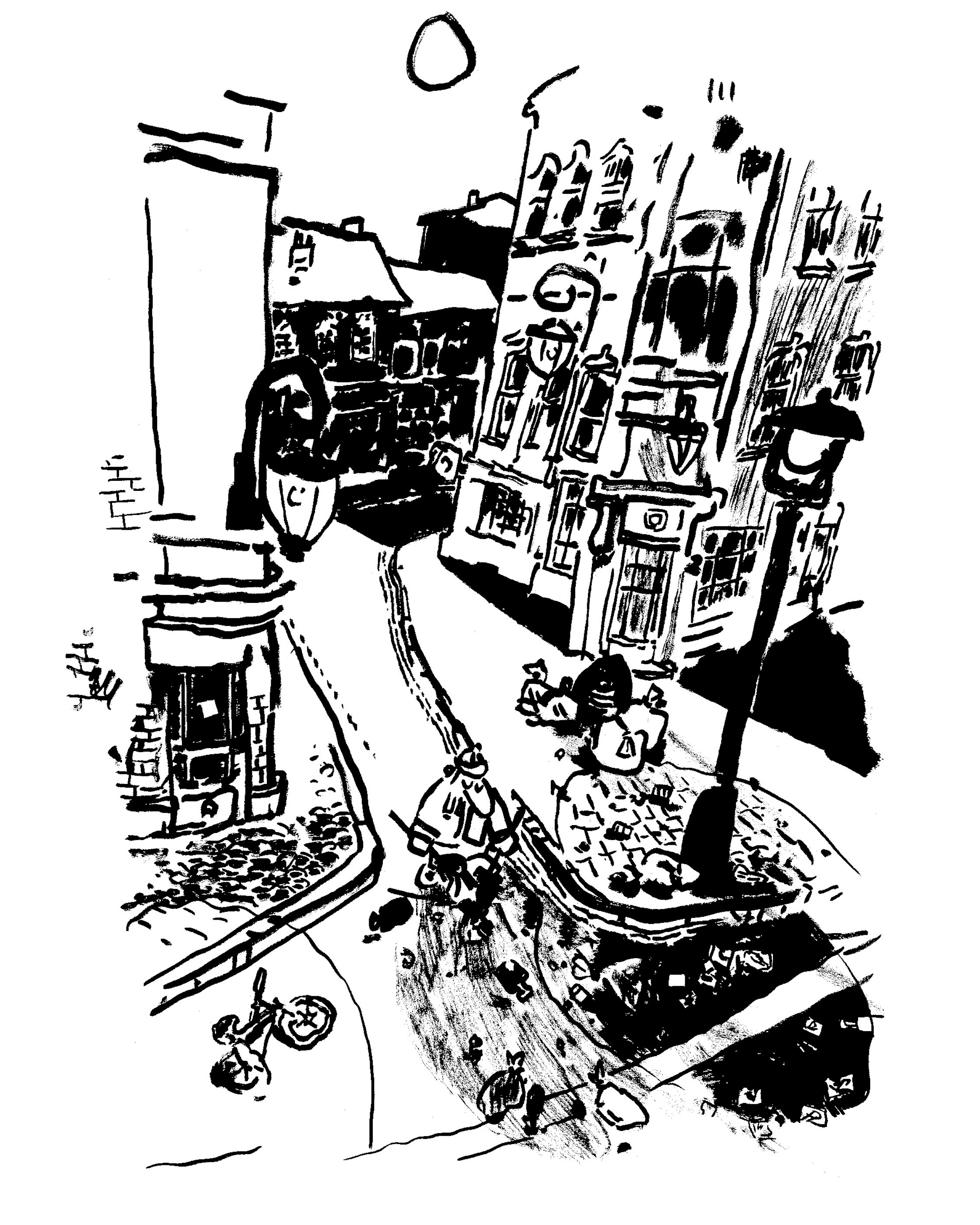In the first days of my son’s life, during the fall of 2023, he spent much of the time when he wasn’t sleeping or eating engaged in what some cognitive scientists call “motor babbling.” His arms and legs wiggled; his eyes wandered and darted, almost mechanically. One night, as he was drifting off to sleep, he smiled for the first time. As I admired him, wondering what he might be thinking about, his expression suddenly went blank—and then, in quick succession, he looked upset, then surprised, and then happy again. It was as if the equipment were being calibrated. That is apparently the purpose of motor babbling: random movements help the brain get acquainted with the body it’s in.
Our intelligence is physical long before it is anything else. Most of our brain mass exists to coördinate the activity of our bodies. (Neuroscientists have found that even when you navigate an abstract space—contemplating, say, your company’s org chart—you use the same neural machinery you’d use to navigate a real space.) A disproportionate amount of the primary motor cortex, a region of the brain that controls movement, is devoted to body parts that move in more complicated ways. An especially large portion controls the face and lips; a similarly large portion controls the hands.
A human hand is capable of moving in twenty-seven separate ways, more by far than any other body part: our wrists rotate, our knuckles move independently of one another, our fingers can spread or contract. The sensors in the skin of the hand are among the densest in the body, and are part of a network of nerves that run along the spinal cord. “People think of the spinal column as just wires,” Arthur Petron, a roboticist who earned his Ph.D. in biomechatronics at M.I.T., said. “No. It’s also brain tissue.” The hand, in particular, is so exquisitely sensitive that “it’s a vision sensor,” he said. “If you touch something in the dark, you can basically draw it.”
I remember the week that my son’s hands came online. We had a spherical toy with a rattle inside, and for weeks he limply ignored it. One day, though, as if by accident, he managed to paw at it. The next day, he could hold on. Within a week, he grasped for it with some intention, and after two weeks he was turning it over in his hand. The remarkable thing about this progression is its extreme rapidity. How can one learn to use so complex a piece of equipment in just two weeks? My son himself seemed impressed. He would look at his palm and flex his fingers, as though wondering, What is this thing, and what else can it do?
Read the rest of this article at: The New Yorker
Soho is poised at a critical juncture. The issue lies in the rancorous disagreements between its various constituents about the kind of future that should be pursued in this square mile of prime real estate. In October, the Mayor of London’s Office overruled the recommendations of local councillors and are now entertaining the idea of pedestrianising the whole neighbourhood, a suggestion that has outraged the dwindling number of people living there.
Soho’s more recent history is often told in terms of steady gentrification, with its sleazy edges smoothed off by the remorseless march of time and capital. Its dense warren of interlocking streets have long carried a reputation for cosmopolitanism, glamour and seediness. And, for centuries, the area has served as the epicentre of London’s sex trade, even in its dwindling contemporary form. As the millennium drew closer, Soho drifted toward respectability, with property prices and commercial rents beginning their steady climb upwards. The transgressive, countercultural neighbourhood of old began morphing into a mainstream tourist destination and hospitality mecca, for good and ill. The sex trade gradually receded – in visibility, at least – to be replaced, the cliché goes, by a neater, more homogenised reality, a process spearheaded by major developers and landowners, like Soho Estates, run by the ebullient John James, and Shaftesbury Capital, founded by the considerably more understated Levy family.
I’d become interested in this increasingly bitter debate around Soho’s future at the start of the year. Having long covered all manner of complicated squabbles across the capital, something in the story felt fresh. If the apparent three-way stand-off between ‘business’, local authority and residents was familiar, the prospect of reporting on it in this part of town was not. Like most Londoners, I have my own private Soho myth kitty, a 15-year-plus patchwork of nights on the tiles, after-work pints, weekend rambles and random, piecemeal weirdness to contend with. And, in trying to unpick the various claims and counterclaims regarding the enrichment or desecration of Soho, I realised that the concerns of the area’s small, centuries-old residential community had never really been factored into them.
Read the rest of this article at: The Fence
If you were looking to this list to help you narrow down your options for the best places to go in Africa in 2025, we’re going to apologize right now: Given the abundance of thrilling new openings to choose from, chances are, when you finish reading, your travel wish list will be longer than ever. But before you blow your budget entirely, a good place to start could be figuring out your “why”—what is it that excites you most about your next trip, and why do you travel?
There are myriad compelling reasons dotting the continent in the year ahead. Do arts and culture appeal to your creative side? Then a landmark museum in Nigeria beckons. If a leisurely sailing journey is your vibe, might we suggest one of several Nile river cruises? There’s something for every kind of beach lover, too—unwind on a secluded Zanzibari strand, cheer on your team at the FIFA Beach Soccer World Cup in Seychelles, or savor under-the-radar culinary discoveries in Djerba, a beguiling Tunisian island that’s been anointed the World Capital of Island Cuisine. Maybe you’re looking for fresh reasons to revisit an old favorite—then look no further than Cape Town and the Winelands, a long-beloved region in the throes of an exciting hotel and restaurant boom. And for anyone plotting out their next big safari, the choices are endless: classics like Tanzania’s Ngorongoro Crater and Uganda’s Bwindi Impenetrable Forest National Park are brimming with stunning new camps, while ambitious openings bring attention to lesser-visited stretches of Zambiaand Kenya. Hmmm—we haven’t made your planning any easier, have we? —Sarah Khan
Read the rest of this article at: Condé Nast Traveler
Nick Cave, one of the most physically expressive figures in rock and roll, was looking at me with suspicion. His eyebrows climbed the considerable expanse of his forehead; his slender frame tensed defensively in his pin-striped suit. I think he thought I was trying to get him canceled.
What I was really trying to do was get him to talk about being a man. For much of his four-decade career fronting Nick Cave and the Bad Seeds, Cave has seemed a bit like a drag king, exaggerating aspects of the male id to amusing and terrifying effect. He performs in funereal formal wear, sings in a growl that evokes Elvis with rabies, and writes acclaimed songs and books brimming with lust, violence, and—in recent years, as he weathered the death of two sons—pained, fatherly gravitas. His venerated stature is more akin to a knighted icon’s than a punk rocker’s; he has been awarded a badge of honor by the Australian government and a fellowship in the United Kingdom’s Royal Society of Literature, and was even invited to King Charles’s coronation, in 2023.
So when I met the 67-year-old Cave at a Manhattan hotel in August, before the release of the Bad Seeds’ 18th studio album, Wild God, I suspected that I might not be alone in wanting to hear his thoughts about the state of masculinity. Meaning: Why are guys, according to various cultural and statistical indicators, becoming lonelier and more politically extreme? I cited some lyrics from his new album that seemed to be about the way men cope with feelings of insecurity and irrelevance, hoping he would elaborate.
Between the long pauses in Cave’s reply, I could hear the crinkling leather of the oversize chair he sat in. “It may be a need that men have—maybe they’re not feeling like they are valued,” he told me, before cutting himself off. “I don’t want to come on like Jordan Peterson or something,” he said, referring to the controversial, right-leaning psychology professor and podcaster who rails against the alleged emasculating effects of modern culture.
Cave seemed taken aback by the idea that he himself was an authority on the subject. “It feels weird to think that I might be tapping into, or somehow the voice of, what it means to be a man in this world,” he told me. “I’ve never really seen that.” In fact, he said, his songs—especially his recent ones—“are very feminine in their nature.”
Its employees are some of its most devoted congregants. “It is the best of the old internet, and it’s the best of old San Francisco, and neither one of those things really exist in large measures anymore,” says the Internet Archive’s director of library services, Chris Freeland, another longtime staffer, who loves cycling and favors black nail polish. “It’s a window into the late-’90s web ethos and late-’90s San Francisco culture—the crunchy side, before it got all tech bro. It’s utopian, it’s idealistic.”
Read the rest of this article at: The Atlantic
The Italian wall lizard—a cigar-size Mediterranean reptile with a green back, mottled copper flanks, and a whiplike tail—is more or less the animal you picture when someone says the word “lizard.” Their ubiquity in places like Pompeii and the Colosseum has earned them the moniker “ruin lizards.” Their known range extends to Slovenia, Croatia, and, since the nineteen-sixties, Long Island, which they may have colonized after making their way out of a Hempstead pet store. Podarcis siculus thrived in the urban wilds of Garden City, feasting on spiders and crickets and sheltering in sidewalk cracks. By the two-thousands, according to one Hofstra University biologist, the area had become home to tens of thousands of the creatures. The New York Lizards, a now-defunct Major League Lacrosse team, adopted a large-eyed lizard as its mascot.
Italian wall lizards have also spread. They have popped up in Pelham Bay Park, in the Bronx; Cypress Hills National Cemetery, on the border of Brooklyn and Queens; and the Baker Athletics Complex, at the northern tip of Manhattan. In 2014, a Greenwich resident reported a sighting on the Facebook page of Connecticut’s environmental-protection agency. The post inspired Colin Donihue, then a Ph.D. student studying lizard evolution at Yale, to visit Greenwich and, in newspapers and on his Web site, solicit more observations from the public. In 2016, he learned that wall lizards were living in Fenway Victory Gardens, in Boston, where they likely overwintered in the heat of compost piles—Fenway’s second-most-famous green monsters. “They can make a lot of different habitats work for them,” Donihue told me. “They’re pretty adapted to living alongside humans.”
Read the rest of this article at: The New Yorker





